Canada 1989 "Exploration of Canada IV, Realizers"
| <prev | back to index | next> |
| Issue Date | 22.03.1989 |
| ID | Michel: 1128-1131, Scott: 1236a-d, Stanley Gibbons: 1319-1322, Yvert et Tellier: 1090-1093, Category: pF |
| Design | Frederick Hagan |
| Stamps in set | 4 |
| Value |
38 cent - Matonabbee travelling North 38 cent - Finding Franklin's Relics 38 cent - Tyrrell has another Find (fossil skull of Albertosaurus sarcophagus) 38 cent - Stefansson on Polar Ice |
| Emission/Type | commemorative |
| Places of issue | Fort Chipewyan |
| Size (width x height) | 12.5mm x 13mm |
| Layout | Sheet of 50 stamps: 10 rows, 5 stamps each |
| Products | FDC x1 |
| Paper | Slater paper (SP) with fluorescent frame (GT4), no Watermark |
| Perforation | 12,50 x 13 |
| Print Technique | Offset lithography |
| Printed by | Ashton-Potter Limited, Canada |
| Quantity | 4,745,250, 3,163,500, 4,745,250, 3,163,500 |
| Issuing Authority | Canadian Post |
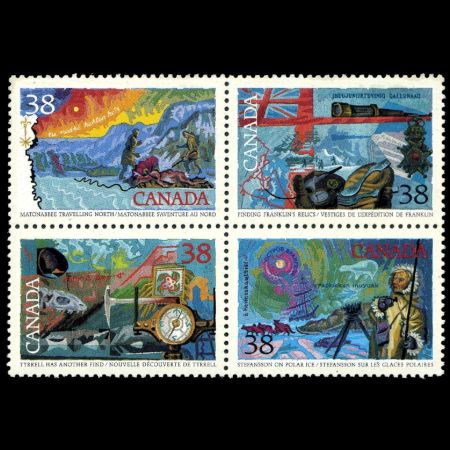
On March 22nd 1989, Canadian Post issued the last stamps set of multi-year series "Exploration of Canada" - "Exploration of Canada (series 4) Realizers". (The first set was issued in 1986). These stamps were printed as a sheet of 50 with 5 stamps per row. Some stamps were printed 2 times in the row, other 3 times.
Frederick Hagan of Newmarket, Ontario, created these four stamps, as well as all other stamps in this multi-year series.
Even today, the Canadian North can appear remote and forbidding. The last four explorers in the Exploration stamp series traversed lands and waters where few now dare to venture.
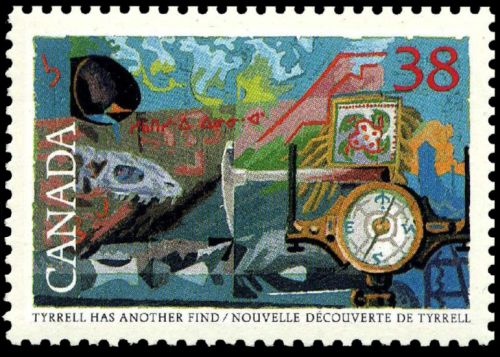
|
| Albertosaurus sarcophagus skull on stamp of Canada 1989 MiNr.: 1130, Scott: 1235. |
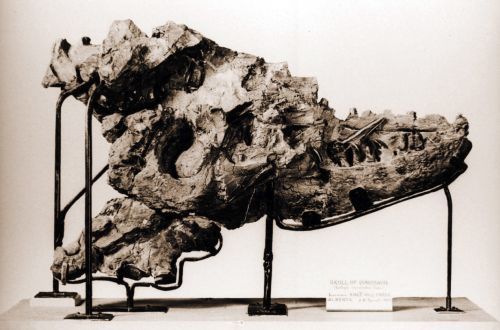 |
| Albertosaurus sarcophagus skull discovered by Joseph Burr Tyrrell in 1884. Image credit: Wikipedia |
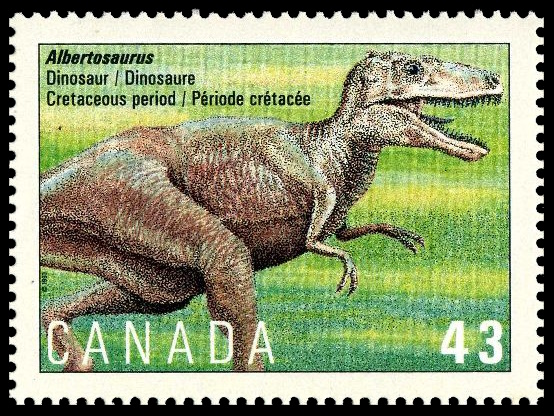
|
| Albertosaurus on stamp of Canada 1993 MiNr.: 1389, Scott: 1497. |
Joseph Burr Tyrrell, FRSC (November 1, 1858 – August 26, 1957) was a Canadian geologist, cartographer, and mining consultant.
On August 12, 1884, Joseph Burr Tyrrell, a geologist with the Geological Survey of Canada, found the 70-million-year-old fossils of a carnivorous dinosaur near present-day Drumheller. Due to a lack of specialised equipment the almost complete skull could only be partially secured.
In 1889, Tyrrell's colleague Thomas Chesmer Weston found an incomplete smaller skull associated with some skeletal material at a location nearby.
Tyrrell’s find was named Albertosaurus sarcophagus (“flesh-eating lizard from Alberta”) in 1905 by American Museum of Natural History palaeontologist Henry Fairfield Osborn. Its namesake is Alberta, the Canadian province established that same year.
Albertosaurus was a genus of tyrannosaurid theropod dinosaurs that lived in western
North America during the Late Cretaceous Period, about 71 million years ago.
The type species, Albertosaurus sarcophagus, was apparently restricted in range to
the modern-day Canadian province of Alberta, after which the genus is named.
As a tyrannosaurid, Albertosaurus was a bipedal predator with tiny, two-fingered hands
and a massive head that had dozens of large, sharp teeth.
It may have been an apex predator in its local ecosystem.
While Albertosaurus was large for a theropod, it was much smaller than its larger and more
famous relative Tyrannosaurus rex, growing up to 8–9 metres in length and weighing 1.7–2.5 tons.
Since the first discovery in 1884, fossils of more than 30 individuals have been recovered,
providing scientists with a more detailed knowledge of Albertosaurus anatomy than
is available for most other tyrannosaurids.
So significant was Tyrrell’s discovery that when the Museum opened its doors to the public on September 25, 1985, it was named in honor of Joseph Burr Tyrrell - the Tyrrell Museum of Palaeontology. (The “royal” appellation was added in 1990.)
Originally intended to serve primarily as a scientific facility, the plans soon changed to include a large public gallery and display area that attracts more than 430,000 visitors annually.
In addition to being a centre of excellence for palaeontology, the Royal Tyrrell Museum displays one of the world’s largest collections of dinosaurs, and has become world-renowned for engaging exhibits and public education programs.
The Royal Tyrrell Museum of Palaeontology is Canada’s only museum dedicated exclusively to the study of ancient life.
The Museum is operated by the Government of Alberta under the Ministry of Culture.
More videos about fossils of the Royal Tyrrell Museum of Paleontology can be watched on YouTube channel of the museum.
Products and associated philatelic items
| FDC | Example of circulated covers | |
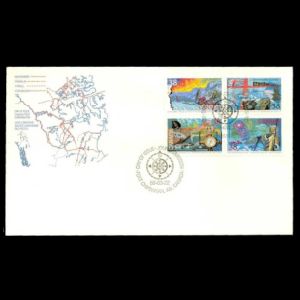 |
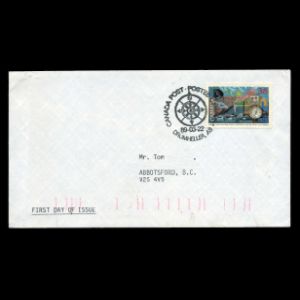 |
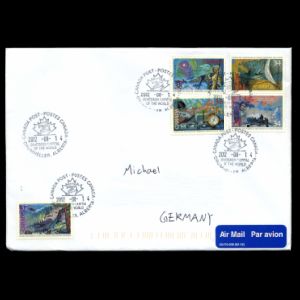 |
| The cachet shows maps of the voyages of exploration. Some of the salient features of the expeditions are shown to provide a sense of the harshness of the conditions the explorers endured. | Customized FDC - the letter was posted on the day of the stamp issue. Since 2001, Drumheller has a permanent postmark: "Drumheller: Dinosaur capital of the world" (see on the right). | "Exploration of Canada IV, Realizers" stamps set of Canada 1989 on circulated cover to Germany, cancelled by permanent postmark of Drumheller - "Drumheller: Dinosaur capital of the world", introduced in 2001. A skull of Albertosaurus sarcophagus is depicted in the postmark. |
References

|
- Technical details and description of the stamps:
The Postage Stamp Press Release of Canada Post Corporation, colnect. - Joseph Burr Tyrrell: Wikipedia
- Albertosaurus: Wikipedia
- Royal Tyrrell Museum of Palaeontology: official website
Acknowledgements
Many thanks to Dr. Peter Voice, PhD Department of Geological and Environmental Sciences, Western Michigan University, USA, for his help in finding information and for review of a draft of this article.| <prev | back to index | next> |